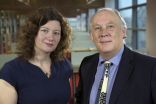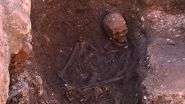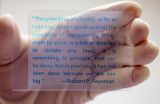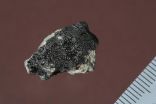Analysis of all the available evidence confirms identity of King Richard III to the point of 99.999% (at its most conservative). Analysis of the mitochondrial DNA shows a match between Richard III and modern female-line relatives, Michael Ibsen and Wendy Duldig. The male line of descent is broken at one or more points in the line between Richard III and living male-line relatives descended from Henry Somerset, 5th Duke of Beaufort. King Richard was almost certainly blue-eyed and probably had blond hair at least during his childhood. The portrait which appears to most closely match the genetically-determined hair and eye colour is the Arched-Frame Portrait in the Society of Antiquaries.
An international research team led by Dr Turi King from the University of Leicester Department of Genetics provides overwhelming evidence that the skeleton discovered under a car park in Leicester indeed represents the remains of King Richard III, thereby closing what is probably the oldest forensic case solved to date.
The team of researchers, including Professor of English Local History, Kevin Schürer, who is also Pro-Vice-Chancellor for Research at the University of Leicester, who led the genealogical research for the project, has published their findings online today (Tuesday 2 December) in the prestigious peer-reviewed journal Nature Communications.
The researchers collected DNA from living relatives of Richard III and analysed several genetic markers, including the complete mitochondrial genomes, inherited through the maternal line, and Y-chromosomal markers, inherited through the paternal line, from both the skeletal remains and the living relatives.
While the Y-chromosomal markers differ, the mitochondrial genome shows a genetic match between the skeleton and the maternal line relatives. The former result is not unsurprising as the chances for a false-paternity event is fairly high after so many generations. This paper is also the first to carry out a statistical analysis of all the evidence together to prove beyond reasonable doubt that Skeleton 1 from the Greyfriars site in Leicester is indeed the remains of King Richard III.
The researchers also used genetic markers to determine hair and eye colour of RIII and found that with probably blond hair and almost certainly blue eyes RIII looked most similar to his depiction in one of the earliest portraits of him that survived, that in the Society of Antiquaries in London.
The research team now plans to sequence the complete genome of RIII to learn more about the last English king to die in battle.
The University of Leicester was the principal funder of the research. Dr King's post is part-funded by The Wellcome Trust and the Leverhulme Trust.
Dr King said:
"Our paper covers all the genetic and genealogical analysis involved in the identification of the remains of Skeleton 1 from the Greyfriars site in Leicester and is the first to draw together all the strands of evidence to come to a conclusion about the identity of those remains. Even with our highly conservative analysis, the evidence is overwhelming that these are indeed the remains of King Richard III, thereby closing an over 500 year old missing person's case."
Professor Schürer added:
"The combination of evidence confirms the remains as those of Richard III. Especially important is the triangulation of the maternal line descendants. The break in the Y-chromosome line is not overly surprising given the incidence of non-paternity, but does pose interesting speculative questions over succession as a result."
Simon Chaplin, Director of Culture & Society at the Wellcome Trust, added: "It is exciting to have access to genetic data from any known historical individual, let alone a king of England lost for more than 500 years, so we are thrilled to be able to support this fascinating project through our Research Resources grant scheme. Adding this information to a wealth of existing material about Richard III further highlights the ways in which studying human remains can inform our understanding of the past, and we look forward to learning more about Richard for many years to come."
INFORMATION:
Researchers at the University of Leicester:
Dr Turi King - Led the research project. Has background in Archaeology and Anthropology from University of Cambridge. Moved into genetics at the University of Leicester nearly 20 years ago. Long history of working in genetic genealogy
Professor Kevin Schürer - Professor of English Local History and Pro-Vice-Chancellor for Research - who led the genealogical research
Dr Jo Appleby - archaeologist/osteologist, excavation of remains
John Holt - Researcher at the Space Research Centre, oversees the clean lab there
Professor David Ekserdjian - Art Historian, advised on portraits
Rita Neumann - research technician in Department of Genetics
Pierpaolo Maisano Delser - researcher, Department of Genetics
Universite Paul Sabatier, Toulouse
Dr Patricia Balaresque - expert in ancient DNA, helped lead the ancient DNA research
Laure Tonasso - research technician, helped with ancient DNA work
University of Potsdam, formerly at the University of York
Professor Michael Hofreiter - eminent expert in ancient DNA, helped lead the ancient DNA research
Dr Gloria Gonzales Fortes - expert in ancient DNA
University College London
Professor Mark Thomas and Professor David Balding - statistics experts
Institute of Legal Medicine, Innsbruck Medical University
Professor Walther Parson - expert in mitochondrial DNA. Oversees database of mitochondrial DNA types from around the world
Bangor University
Dr Michael Knapp - an expert in ancient DNA
Yale University
Dr Susan Walsh - expert in hair and eye colour prediction from DNA analysis
Erasmus MC University Medical Centre
Professor Manfred Kayser - expert in hair and eye colour prediction from DNA analysis
University of Cambridge
Dr Peter Forster - oversees database of mitochondrial DNA types
The Dig for Richard III was led by the University of Leicester, working with Leicester City Council and in association with the Richard III Society. The originator of the Search project was Philippa Langley of the Richard III Society
About the Wellcome Trust
The Wellcome Trust is a global charitable foundation dedicated to improving health. We provide more than £700 million a year to support bright minds in science, the humanities and the social sciences, as well as education, public engagement and the application of research to medicine.
About the Leverhulme Trust
The Leverhulme Trust was established by the Will of William Hesketh Lever, the founder of Lever Brothers. Since 1925 the Trust has provided grants and scholarships for research and education; today it is one of the largest all-subject providers of research funding in the UK, distributing over £60 million a year.









